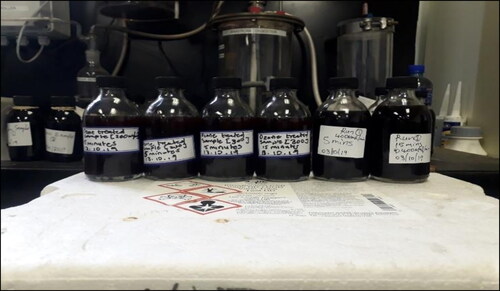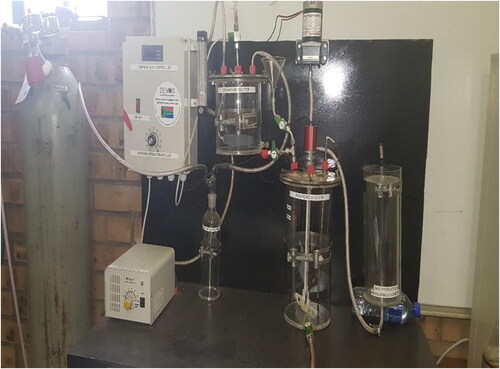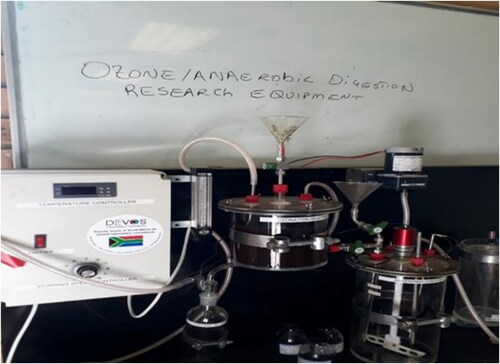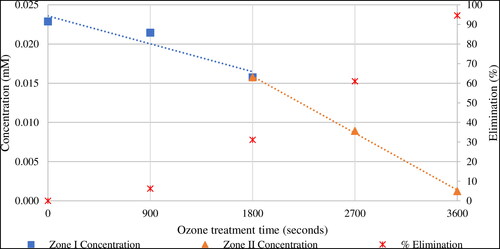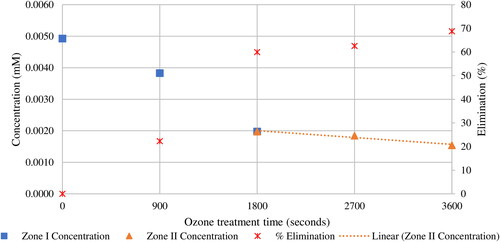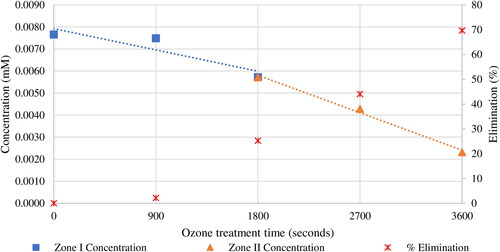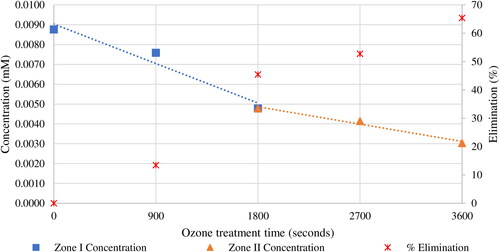 ?Mathematical formulae have been encoded as MathML and are displayed in this HTML version using MathJax in order to improve their display. Uncheck the box to turn MathJax off. This feature requires Javascript. Click on a formula to zoom.
?Mathematical formulae have been encoded as MathML and are displayed in this HTML version using MathJax in order to improve their display. Uncheck the box to turn MathJax off. This feature requires Javascript. Click on a formula to zoom.Abstract
Large volumes of wastewater are generated during petroleum refining processes. Petroleum refinery wastewater (PRW) can contain highly toxic compounds that can harm the environment. These toxic compounds can be a challenge in biological treatment technologies due to the effects of these compounds on microorganisms. These challenges can be overcome by using ozone (O3) as a standalone or as a pretreatment to the biological treatment. Ozone was used in this study to degrade the organic pollutants in the heavily contaminated PRW from a refinery in Mpumalanga province of South Africa. The objective was achieved by treating the raw PRW using ozone at different ozone treatment times (15, 30, 45, and 60 min) at a fixed ozone concentration of 3.53 mg/dm3. The ozone treatment was carried out in a 2-liter custom-designed plexiglass cylindrical reactor. Ozone was generated from an Eco-Lab-24 corona discharge ozone generator using clean, dry air from the Afrox air cylinder as feed. The chemical oxygen demand, gas chromatograph characterization, and pH analysis were performed on the pretreated and post-treated PRW samples to ascertain the impact of the ozone treatment. The ozone treatment was effective in reducing the benzene, toluene, ethylbenzene, and xylenes (BTEX) compounds in the PRW. The 60-min ozone treatment of different BTEX pollutants in the PRW resulted in the following percentage reduction: benzene 95%, toluene 77%, m + p-xylene 70%, ethylbenzene 69%, and o-xylene 65%. This study has shown the success of using ozone in reducing the toxic BTEX compounds in a heavily contaminated PRW.
Introduction
Petroleum refineries worldwide use crude and synthetic oil to produce a wide range of refined products, such as petrol, diesel, kerosene, and jet fuel. Significant quantities of water are used during the petroleum refining process, and large volumes of wastewater are generated.[Citation1] The volume of wastewater and its characteristics depend on the complexity of the refinery processes, the configuration used, the feedstock, and the chemicals used. Petroleum Refining Wastewater (PRW) is a general term used for the wastewater produced by the petroleum refining industries.[Citation2] The presence of toxic phenolic compounds on some of the aromatic hydrocarbon compounds found in the PRW makes them not readily biodegradable, resulting in the PRW not being treated effectively with biological treatment.[Citation2] PRW can contain physical, chemical, and biological pollutants. The high toxicity of these pollutants in the PRW can destroy the environment.[Citation3] The high concentrations of benzene, toluene, ethylbenzene, and xylene (BTEX) in the PRW are of significant concern due to their toxicity and carcinogenicity. Their toxicity can also lead to liver, lung, kidney, and vascular system infections.[Citation4]
Petroleum wastewater must be treated before discharge to reduce its adverse environmental effects. Physical, chemical, and biological treatment processes treat the PRW.[Citation5] Several methods, such as coagulation, adsorption, chemical oxidation, membranes, microwave-assisted catalytic wet air oxidation, and biological techniques (anaerobic and aerobic digestion), are used to reduce or remove pollutants in wastewater.[Citation6–8] The choice of which treatment process to use on the PRW depends on the composition of the PRW, which depends on the crude oil quality, process operating conditions, and sources of wastewater pollutants.[Citation9] Treatment with a high concentration of complex organic waste compounds can be a challenge in anaerobic digestion since these compounds are toxic to the micro-organisms, and the micro-organisms that are biodegrading the waste are sensitive to environmental changes.[Citation1]
Prior to the biological treatment, a pretreatment process for the PRW is required to increase the removal efficiency of the pollutants so that discharge standards are met.[Citation2] Pretreatment technologies are used to degrade the PRW, resulting in an increased biodegradability of the PRW in the anaerobic digester.[Citation10] Fenton, photo-Fenton, enhanced photo-degradation, oxidation, biodegradation, membrane bioreactor, flocculation, ceramic membrane filtration, and electrochemical processes are the typical pretreatment technologies used for the PRW.[Citation11–14] These pretreatment technologies operate by eliminating the organic compounds present in the PRW or by increasing the biodegradability of the PRW.[Citation15] A review of the PRW treatment technologies was conducted and showed that the PRW treatment has two stages: pretreatment and advanced. Grease, oil, and suspended materials are reduced in the pretreatment stage, while the remaining pollutants are degraded and reduced to acceptable discharge standards in the advanced treatment stage. The PRW treatment must be sufficient to meet the requirements of established regulatory bodies, such as the Environmental Protection Agency. For example the EPA regulates pollutant limits in petroleum refining wastewater (PRW) effluent are pH levels normally falling between 6 and 9, Total Suspended Solids (TSS) at 30 mg/L, and Oil and Grease (O&G) at 10 mg/L.[Citation9] Ozone is one of the methods used for wastewater treatment, and it falls under chemical oxidation.[Citation3]
Ozone is a powerful oxidant that can be used in wastewater treatment. When ozone is dissolved in wastewater, it reacts with organic compounds in the wastewater. Because of its potent oxidizing abilities, ozone is used as a water treatment technique. Ozone interacts with organic substances in wastewater by either producing secondary oxidants such hydroxyl radicals or by directly oxidizing the organic components. The wastewater treatment process is improved by this procedure, which efficiently breaks down contaminants into simpler, less hazardous compounds. The reaction occurs in two different ways: direct oxidation through molecular ozone or indirect response through the formation of secondary oxidants such as hydroxyl radicals.[Citation14] Both ozone and hydroxyl radicals are strong oxidants capable of oxidizing several compounds. Ozone treatment of the PRW is required to degrade the organic contaminants as a standalone technology or before it is sent to the biological treatment section (anaerobic or aerobic digestion) to prevent harmful effects to the environment and aquatic life.[Citation14] Ozone has been used in wastewater treatment due to its multiple oxidizing effects since ozone has a high oxidizing potential (2.07 V). In comparison, the formation of hydroxyl radicals during its decomposition has an even higher oxidizing potential (2.80 V).
Ozone can convert a large number of complex pollutants in the PRW treatment into simple, less toxic, and biodegradable compounds as no harmful by-products or waste is typically generated. According to Brooms et al., smaller molecules are usually readily biodegradable. If the organic pollutant wholly reacts with ozone, the residual products will be CO2 and H2O.[Citation16] One of the advantages of using ozone is its ability to disinfect without adding other chemicals that may later need to be removed.[Citation3] The other advantage of using ozone in the PRW treatment is that it is simple to operate, and no additional chemicals are required. Ozone pretreatment technology is easy to implement in already existing PRW treatment plants. The main disadvantage of using ozone that has been mentioned in recent literature is its high cost.[Citation14]
Direct oxidation favors atoms with a negative charge density (e.g., N, P, O), nucleophilic carbons, and multiple bonded constituents such as carbon-carbon and nitrogen-nitrogen.[Citation17] The ozone reacts with the carbon double bond (unsaturated) due to its dipolar structure, which leads to the splitting of the bonds. The hydroxyl radical can degrade the compounds refractory to ozone.[Citation2] The decay or decomposition of ozone is influenced by many factors, especially in the presence of other compounds. These factors include ozone concentration, pH, temperature, fluid-dynamic conditions, the presence of UV radiation, hydroxyl radicals, the concentration of pollutants in the PRW (mainly inorganic and organic carbon) that act as scavengers or promoters, and the anions or cations.[Citation5]
The ozone reaction with pollutant compounds in the PRW tends to be highly selective, with slower reaction rates. In contrast, reactions with the hydroxyl radical are nonselective, resulting in faster reaction rates.[Citation16] The occurrence of slower and faster reactions will mean that there will be two zones in the degradation of organic compounds. In the slower and more selective reaction zone, ozone mainly reacts with the organic compounds as the hydroxyl radical population is still low. In the faster and nonselective reaction zone, the hydroxyl radicals are mainly reacting with the organic compounds.[Citation11]
This research aimed to look at how ozone treatment affects the effectiveness of removing certain refractory chemicals such as polycyclic aromatic hydrocarbons (PAHs), chlorinated compounds from wastewater used in petroleum refining. Through a thorough methodology, the study aims to comprehend the processes behind the breakdown and elimination of chemicals by ozone. This study’s results might substantially influence the creation of effective and sustainable methods for treating wastewater from petroleum refining, reducing the negative environmental effects of these industrial activities.
Materials and methods
Materials and chemicals
Petroleum wastewater effluent high in aromatic compounds and hydrocarbons was collected from the refinery. Three 20 liters of wastewater were obtained from M Refinery from one batch of the PRW for consistency, and there was no need to prepare a synthetic water sample since enough PRW was collected. The visible floating oil in the sample was skimmed off. The PRW was stored in the fridge for future use at 4 °C before treatment and post-treatment in . The storage temperature of 4 °C was selected to preserve the sample. The treated and unused wastewater was returned to the refinery for disposal once the experiments were completed. The PRW sample was analyzed to obtain its characteristics to assess the impact of ozone treatment. Clean, dry, and compressed air was used for the ozone treatment experiments due to the laboratory’s limited ventilation and low risk of explosion compared to a 99% oxygen cylinder. The dry air was supplied at high pressure in metal cylinders. The composition of this dry compressed air was: moisture <10 volume per million, nitrogen 78%, oxygen 21%, argon 0.9%, and carbon dioxide 0.03%. The box of 150 chemical oxygen demand (COD) vials was purchased from United Scientific South Africa. All the analytical grade chemicals, such as hydrochloric acid (≥99%) and sodium hydroxide (≥99%), were purchased from Sigma Aldrich. Deionized water and distilled water were produced in the laboratory.
Methods
The 20-liter container storing the PRW was removed from the refrigerator unit and left in the laboratory overnight to allow it to adjust to room temperature. The following day, it was mixed continuously using a shaker for 5 min to homogenize the wastewater sample. A sample of 500 mL of raw PRW was drawn and characterized in the GC. An aliquot of 1.5 L of the PRW was drawn from the 20-liter container and poured into the reactor using the glass funnel. The ozone reactor vent valve was opened to allow exhaust gas to move to the scrubber and then vented to the atmosphere. The Eco-Lab-24 ozone generator was switched on and set at 100% to get the maximum electric current to maximize the ozone output from the ozone generator. The air cylinder valve was opened, and the airflow rate was set at 1500 NmL/min (1.61 L/min). Based on the ozone generator manual, the ozone output concentration at the air flow rate of 1.61 L/min was 3.53 mg/dm3. The airflow rate was fixed throughout the experiments. The 1.5 liters of the PRW in the reactor were ozonated at different time intervals: 15 min, 30 min, 45 min, and 60 min. During each run, the temperature, airflow, and pH were monitored. Once each time interval had elapsed, one liter was drawn from the reactor for analysis and characterization (GC analysis and COD). The reactor was cleaned several times using dishwashing liquid. It was rinsed with distilled water. After cleaning the reactor, the same procedures were repeated for the following experimental run.
Experimental setup and process equipment
The actual laboratory equipment used in this study is shown in . The laboratory equipment consisted of a laboratory-scale dry air cylinder, ozone generator, ozone reactor, stone diffuser, valves, control box panel, and exhaust gas scrubber. There was a control box panel with a 12 V transformer, temperature control, and a three-speed controller. The three-speed controller was used to control the stirring speed in the ozone treatment reactor. The temperature control displayed and controlled the temperature in the ozone treatment reactor. The ozone treatment reactor had cartridge heating elements to control the reaction temperature.
The Eco-Lab-24 ozone generator generated ozone gas from the air cylinder (). The Eco-Lab-24 ozone generator used corona discharge to generate ozone. Clean, dry air from the cylinder was fed into the ozone generator using the Afrox high-pressure air regulator valve to control the flow.[Citation16] Downstream, between the ozone generator and the ozone reactor, a Vögtlin rotameter was installed to measure the flow rate of ozonated air to the reactor. The amount of ozone formed could be adjusted by adjusting the intensity of the electrical current. This was set at 100% to maximize the ozone formed since we were dealing with heavily contaminated PRW. The ozone reactor had a stone diffuser at the bottom center of the reactor, which created a large surface area for the ozone to diffuse through the PRW during treatment.[Citation3] The connecting lines were made from polyvinyl chloride (PVC), and the valves were made from stainless steel. The ozone treatment reactor was a custom-designed plexiglass cylinder with an inside diameter of 140 mm and a height of 150 mm, with a total working volume of about 2 liters. The reactor had a top lid that could be removed during cleaning. An inlet funnel with a gate valve at the top feeds the PRW directly to the reactor. The ozone treatment reactor was operated in a semi-batch mode. A fixed volume of 1.5 liters of the PRW was added to the reactor, while ozone gas was continuously fed to the reactor. The residual ozone and exhaust gases from the ozone treatment reactor were collected on top of the reactor and passed through an inline-activated gas scrubber unit. The gas scrubber uses activated carbon to absorb and neutralize the ozone emission and other gases. Samples were then collected at the bottom of the reactor through a 1-inch diameter PVC pipe with a gate valve at the bottom of the ozone reactor. The samples were analyzed for COD and pH and characterized using gas chromatography (GC). The experiments were done three times for reliability.
The experiment design for this research was one factor at a time. The parameters measured throughout the experiments include the ozone treatment times, pH, temperature, concentration, and COD. In the first set (run 1) of the ozone treatment experiments, the airflow rate (1.61 L/min), ozone output (8.05 mg/min), pH (9.67, initial pH of FFS PRW), and temperature (25 °C) were fixed, while the ozone treatment time was varied at 15 min interval (0, 15, 30, 45 and 60 min). The second and third sets of experiments were to investigate the effect of pH on the ozone treatment of FFS PRW. The air flow rate, ozone output, and temperature were fixed, while the FFS PRW pH varied, as per . For each pH, the ozone treatment was run from 0 to 60 min at a 15 min interval. The fourth and fifth sets of ozone treatment experiments were carried out to investigate the effect of temperature on the ozone treatment of FFS PRW. The air flow rate, ozone output, and pH were fixed, while the FFS PRW temperature varied, as per . For each temperature, the ozone treatment was run from 0 to 60 min at a 15 min interval.
Table 1. Experiments design for the ozone treatment reactions.
Characterization of PRW
The COD and GC characterization were performed on the pretreated and post-treated PRW samples to ascertain the impact of the ozone treatment.[Citation18] The COD was measured using the readily prepared COD vials. The vials were for the highest COD range of 0–15,000 mg/L (high range plus, H+). Due to the high COD content of the PRW, the COD reading was above the 0–15,000 mg/L range. The untreated wastewater sample had a COD of 48,000 mg/L. The sample was then diluted into a dilution factor of 4 by adding three parts of deionized water to one part of the PRW sample.[Citation5] The treated and untreated PRW samples were analyzed using GC to evaluate the effectiveness of ozone treatment and the effect of the varied operating parameters. The sample components were characterized using the GC/MS installed with the WAX capillary column. The 1, 4-Dioxane was used as an internal standard. The carrier gas used was hydrogen. The analytical conditions were as follows: the temperature at 35 °C with the isothermal operation for 5 min, heating to 145 °C at a constant rate of 12 °C/min, and heating to a temperature of 240 °C at a continuous rate of 20 °C/min with 20 min isothermal. The operating parameters are summarized in .
Table 2. GC operating conditions during analysis.
Ozone treatment reaction kinetics
In this experiment setup, the fixed amount of ozonated air (1.61 L/min) was continuously supplied to 1.5 L of petroleum wastewater. The ozone concentration can, therefore, be assumed to be constant in the reactor compared to the organic compounds that are continuously reacting with ozone. The reactor’s constant ozone concentration falls under the pseudo rate laws category. The pseudo conditions mean that the change in concentration of one of the reactants is negligible (when supplied in excess) compared to the other reactant, which is reducing over time. The pseudo conditions would not be valid if the ozone concentration were changed during the experiments.[Citation2] The difference between a pseudo-first-order and a first-order reaction is that the pseudo-first-order reaction is a reaction that should have taken place by some higher-order (greater than 1) but has taken place by first-order due to the constant concentration of one of the reactants. At the same time, the first-order reaction (EquationEquation 1(1)
(1) ) is a reaction that is only affected by the concentration of one of the reactants. The other reactant does not influence the reaction.[Citation19]
(1)
(1)
The pseudo-first-order reaction kinetics were modeled by plotting As a function of time. This plot should yield a straight line with R2 close to 1 if the reaction is pseudo-first-order, with a gradient that is equal to
The pseudo-second-order was also evaluated to ascertain that the reaction is pseudo-first-order.[Citation20] The overall third-order ozone treatment reaction is given in EquationEquation 2(2)
(2) .
(2)
(2)
The pseudo-second-order kinetics were modeled by plotting As a function of time. This plot should yield a straight line with R2 close to 1 if the reaction is pseudo-second-order, with the slope equal to
The pseudo-zero-order reaction kinetics is given by EquationEquation 3(3)
(3) .[Citation18]
(3)
(3)
The pseudo-zero-order kinetics were modeled by plotting As a function of time. This plot should yield a straight line with R2 close to 1 if the reaction is pseudo-zero-order, with a slope that is equal to
It was not only the R2 method used to determine the order. The other test was based on whether the reaction rate constants of Zone I (direct ozone reaction) and II (hydroxyl radical reaction) follow what is taking place in those zones.[Citation21] For example, if the reaction rate constant of Zone I is higher than the reaction rate constant of Zone II, this will mean that the bulk reaction is taking place in Zone I. This was then tested against the percentage removal of the organic pollutant in that zone. If the percentage removal were now higher in Zone II than in Zone I, this would mean that the kinetic model does not correspond with what is happening and, therefore, is incorrect.[Citation22]
Results and discussions
Characteristics of FFS PRW
The PRW sample was analyzed using GC. The composition of the BTEX in the PRW before treatment is shown in . There was a considerable amount of BTEX compounds in the PRW. The high concentrations of BTEX are of serious concern due to the toxicity and carcinogenicity of these compounds.[Citation23] The compounds with the highest concentration in the PRW were the toluene and benzene, at 2560 mg/L and 1787 mg/L, respectively. Ethylbenzene had the lowest concentration, while the m + p-xylene and o-xylenes were in mid ranges at 812 mg/L and 930 mg/L, respectively. The methyl tert-butyl ether was less than 50 mg/L in the sample and could not be studied further, as all the GC analyses of the treated samples showed less than 50 mg/L. The gasoline range hydrocarbons, the C10–C28, were less than 10 mg/L in the sample and could not be studied further as the treated sample GC results showed the same reading of less than 10 mg/L. Other compounds in FFS PRW sample were present in less than 50 mg/L; therefore, their exact quantities could not be identified and studied further were the polyaromatic hydrocarbons such as acenaphthylene (C12H8), acenaphthene (C12H10), fluorine (C13H10), anthracene (C14H10) and phenanthrene (C14H10).
Table 3. Characterization of FFS PRW for organic compounds.
The COD of the PRW is shown in . It can be seen that the highest COD in the previous studies that were reviewed on wastewater treatment was 21,000 mg/L. The COD for the PRW in the current study was 48,524 mg/L, which is approximately 2.3 times the COD reported by Dincer. The PRW in this study was heavily contaminated with organic and inorganic pollutants. Even the color of this wastewater was dark maroon, indicating the high contamination levels.[Citation24,Citation25]
Table 4. The FFS PRW’s COD as compared to other PRW.
The two-zone reaction kinetics
The two competing kinetics for the ozone and hydroxyl radicals reactions with the organic pollutants were observed. The two zones can be seen in . The transition between the two zones was witnessed after 30 min of ozone treatment. The first zone (Zone I) is characterized by a sharp increase in dissolved ozone concentration. The sample is saturated with ozone in the second zone (Zone II). In Zone I, it is mainly the ozone reacting, while in Zone II, it is mainly the hydroxyl radical reacting.[Citation3] Both the hydroxyl radical and ozone reactions are still taking place in Zone I and Zone II. The hydroxyl radical formation during ozone decomposition makes it kinetically complex since the ozone and the hydroxyl radicals must be accounted for when determining the reaction kinetics.[Citation18] The ozone reaction was under the pseudo conditions for ozone, as the sample was saturated with a continuous flow of ozone for the duration of the ozone treatment experiments (
The selection of reaction order of whether pseudo-zero-order, pseudo-first-order, or pseudo-second-order was based on whether the reaction rate constants of Zone I and II follow what is taking place in Zones. If the reaction rate constant of Zone I is higher than the reaction rate constant of Zone II; it means that the bulk reaction is taking place in Zone I. If the percentage removal of the organic pollutant was now higher in Zone II than in Zone I, it means there is a wrong fit of the kinetic model.[Citation26] The R-squared (R2) method was also used to select the model that better fits the experimental data.[Citation27] The rate constant for the ozone treatment reaction in Zone I is summarized in together with R2. Zone 1 is dominated by ozone reaction, which is slow and highly selective. As seen in , ozone was highly reactive toward the 1,3,5-trimethylbenzene and ethylbenzene, where the percentage removal of these compounds was about 66.82% and 59.93% respectively. The resulting reaction rate constant for the 1,3,5-trimethylbenzene was 6.128 × 10−4 s−1, while for the ethylbenzene was 5.080 × 10−4 s−1. The reaction rate constant was directly proportional to the percentage of removal for each of the compounds.
Table 5. Zone I ozone treatment reaction kinetics and removal efficiency.
lists the reaction rate constants and the percentage removal for the second ozone treatment stage (Zone II), mainly controlled by the hydroxyl radicals. The hydroxyl radical is nonselective and reacts immediately compared to ozone, which is slower and more selective. Benzene and toluene had the highest elimination in Zone II, each with 63.44 and 64.42% removal, respectively. In the benzene compound, the benzine ring has no external structure attached to it. The attack by the hydroxyl radical on the double bond will result in the decyclization of the ring and further decomposition.[Citation25] The toluene has an organic structure similar to phenols, which are highly reactive toward hydroxyl radicals. The phenols have an OH attached to the benzene ring, while toluene has a methyl group (CH3) attached to the benzene ring. The electrophilic attack of the hydroxyl radical on the attached structure will result in decylization and further decomposition of the compounds to form CO2. The compounds highly reactive to the ozone in Zone I were the least reactive with the hydroxyl radical in Zone II. The main reason for this could be the reduced concentration of these compounds in Zone II. The percentage removal of these compounds was less than 25%, with 1,3,5-trimethylbenzene having 2.29% removal in zone II.[Citation21]
Table 6. Zone II ozone treatment reaction kinetics and removal efficiency.
The pseudo-second-order kinetics for the ozone treatment reactions were also studied. However, the pseudo-first-order reaction kinetics were selected because the R2 value was closer to 1 and based on many researchers that observed the first-order reaction with regard to ozone and the first-order reaction based on the organic compound reacting with ozone.[Citation16] The second-order reaction kinetics results are summarized in . It can be seen that the R2 values of these organic compounds in are much less than those in and , indicating a better fit of the ozone treatment reaction kinetic model to the pseudo-first-order. Implying that the rate-limiting step in the degradation process is predominantly governed by the concentration of ozone rather than the concentration of the organic compounds.
Table 7. Zone I and Zone II ozone treatment pseudo-second-order reaction kinetics.
Effect of ozone treatment on organic compounds
The PRW treatment using ozone was very effective in reducing the refractory pollutants in this wastewater that cannot be removed easily using the traditional biological treatment, as the removal efficiency of organic pollutants ranged from 65% to 95%. The ozone treatment effectively reduced the benzene in the PRW, as 95% of the benzene in the initial sample was eliminated after 60 min of ozone treatment. shows the effect of ozone reduction on benzene concentration and the percentage elimination of benzene. The initial concentration of benzene in the petroleum was reduced by 6.27% from 0.0229 mM to 0.0214 mM after 15 min of treatment with ozone. A benzene reduction of 31% was achieved after the ozone treatment of 30 min as the concentration was reduced to 0.0158 mM. An ozone treatment of 45 min and 60 min reduced the initial benzene concentration of 61% and 95%, respectively. After 60 min of ozone treatment, the initial concentration of benzene, 0.0229 mM, was reduced to 0.0012 mM. The different slopes of Zone I and Zone II are also noticed in . Zone I have a slow ozone treatment rate, and the direct ozone reaction mainly controls the reaction.[Citation14]
Zone II has a faster ozone treatment rate, where the hydroxyl radicals mainly react.[Citation16] Out of the 95% of benzene removed by ozone, only about 31% of the initial benzene concentration was removed in Zone I. The ozone treatment in Zone II resulted in a further benzene reduction of approximately 64%. About double the benzene concentration in the first 30 min was removed in the last 30 min of ozone treatment. The 60 min ozone treatment of the PRW resulted in 77% elimination of the toluene that was initially present in the sample.
The effect of ozone on toluene in the PRW sample can be seen in . The initial toluene concentration of 0.0278 mM was reduced by 5.46% to 0.0263 mM after 15 min of ozone treatment. The percentage reduction of toluene went to 12.79% after 30 min of ozone treatment as the concentration of toluene was reduced to 0.0242 mM. Ozonating the petroleum wastewater for 45 min and 60 min decreased the toluene concentration to 0.0162 mM and 0.0063 mM, respectively. After 45 min of ozone treatment, the percentage reduction of toluene was 42%, and after 60 min, it went to 77%. The percentage reduction of toluene after 60 min of ozone treatment was lower than that of benzene, which went to 95%. The initial concentration of the pollutants in the PRW significantly impacts the ozone treatment reaction rate.[Citation8] About 13% of the initial toluene concentration was removed in the first 30 min in Zone I, and the last 30 min of the ozone treatment resulted in a further removal of 64.42% toluene in Zone II. About five times the amount of toluene concentration removed in the first 30 min was removed in the last 30 min of ozone treatment due to the nonselective and faster hydroxyl radicals.[Citation25]
During the 60 min of the PRW ozone treatment, about 69% of the ethylbenzene in the sample was eliminated. The reaction of ethylbenzene with ozone showed different results than benzene and toluene.[Citation4] As seen in , most of the reaction occurred during the first 30 min in Zone I. About 60% of the initial ethylbenzene concentration was removed in Zone I. A further 9% of ethylbenzene was removed in Zone II. Ethylbenzene was one of those selective compounds favored by the ozone reaction in Zone I. During the first 15 min, the initial ethylbenzene concentration of 0.0049 mM was reduced by 22% to 0.0038 mM. Treating the PRW with ozone for 30 min resulted in a 60% reduction in the initial ethylbenzene concentration, with the ethylbenzene concentration at 0.0020 mM. Ozonating for 45 min resulted in a low decrease of ethylbenzene of 63% compared to the 60% reduction achieved during 30 min of ozone treatment. The ethylbenzene concentration was reduced to 0.0018 mM and 0.0015 mM after ozonating for 45 min and 60 min, respectively.
Ozone treatment effectively eliminated approximately 70% of the m + p-xylene compounds initially present in the PRW sample. The m-xylene and p-xylene are combined on the GC report due to their boiling points, which are 0.6 °C apart. M-xylene boils at 139 °C, while p-xylene boils at 138.4 °C. The effect of ozone on m + p-xylene is shown in . Only 2.15% of the m + p-xylene was reduced during the first 15 min, resulting in the initial concentration of m + p-xylene dropping from 0.0077 mM to 0.0075 mM. The low reduction of the compound during the first 15 min can be attributed to the low dissolved ozone concentration. This can also be attributed to the complex structures of these compounds.[Citation5]
M-xylene, p-xylene, o-xylene, and ethylbenzene have the same chemical formula but different chemical structures. Ozonating the petroleum wastewater for 30 min reduced m + p-xylene concentration by 25% to 0.057 mM. The m + p-xylene concentration was reduced to 0.0043 mM and 0.0023 mM after 45 min and 60 min of ozone treatment, respectively. This represented a 44% reduction at 45 min and a 70% reduction after 60 min. Out of the 70% of m + p-xylene removed during the ozone treatment, only about 25% of the initial concentration was removed in the first 30 min in Zone I, and the last 30 min of the ozone treatment resulted in a further m + p-xylene reduction of approximately 45%. Most m + p-xylene removal occurred in Zone II due to the hydroxyl radicals, comparable to the benzene and toluene ozone treatments, as most of the reaction occurred in Zone II.[Citation28]
About 65% of the o-xylene initially present in the PRW sample was effectively eliminated during the 60 min of ozone treatment. shows the reduction of o-xylene concentration as a function of ozone treatment time. Much of the reaction of o-xylene and ozone occurred during the first 30 min in Zone I. O-xylene was one of those compounds favored by the ozone reaction in Zone I, as was the case with ethylbenzene. About 45% of the initial ethylbenzene concentration was removed in Zone I. A further 20% of ethylbenzene was removed in Zone II.[Citation29]
The reaction of o-xylene with ozone is the same as reaction 3. The initial concentration of o-xylene 0.0088 mM was reduced to 0.0076 mM during the first 15 min of ozone treatment. This 13% o-xylene concentration reduction in the 15 min of ozone treatment increased to 45% when the ozone treatment time was increased to 30 min, reducing o-xylene to 0.0048 mM. Ozone treatment of the PRW for 45 and 60 min decreased o-xylene to 0.0041 mM and 0.0030 mM, respectively. This was a 53% o-xylene reduction after 45 min and a 65% reduction after 60 min.[Citation30]
Conclusion
This study investigated the removal efficiency of BTEX in PRW using ozone treatment. The 60-min ozone treatment of different organic pollutants in PRW, at a fixed ozone concentration resulted in the reduction of the pollutants. Benzene reported the highest removal efficiency due to its more straightforward chemical structure than other compounds studied. Toluene had the second simplest structure, resulting in toluene having the second highest removal efficiency. The 60-min ozone treatment of m + p-xylene, ethylbenzene, and o-xylene showed good removal efficiency. The structures of m + p-xylene, ethylbenzene, and o-xylene compounds are more complex than toluene and benzene, contributing to the lower removal efficiency. This study has shown the success of using ozone in reducing the toxic BTEX compounds in a heavily contaminated PRW. Therefore, Ozone treatment technology can be considered to treat PRW as a standalone technology or a pretreatment for biological treatment plants.
Authors contributions
Nkosinathi Khoza: conceptualization, methodology, formal analysis, investigation, investigation, data curation, writing-original draft. Tumisang Seodigeng: formal analysis, investigation, data curation, writing-reviewing, and editing. Musamba Banza: formal analysis, investigation, data curation, writing-reviewing, and editing. Aoyi Ochieng: formal analysis, investigation, data curation, writing-reviewing, and editing.
Abbreviations/Nomenclature
| PRW | = | Petroleum refining wastewater |
| FFS | = | Fuel Firing System Refinery |
| COD | = | Chemical oxygen demand |
| GC | = | Gas Chromatography |
| BTA | = | 1H-Benzotriazole |
| mbpd | = | Million barrels per day |
| BTEX | = | Benzene, toluene, ethylbenzene, and xylenes |
| THM | = | Trihalomethanes |
| VOC | = | Volatile organic compounds |
| PVC | = | Polyvinyl chloride |
| vpm | = | Volume per million |
| AOPs | = | Advanced oxidation processes |
| mM | = | mmol/L |
Acknowledgments
Vaal University of Technology is acknowledged for providing facilities.
Disclosure statement
The authors declare that they have no known competition for financial interests or personal relationships that could have influenced the work reported in this paper.
Data availability statement
The data presented in this study are available on request from the corresponding author.
Additional information
Funding
References
- Bastos, P. D. A.; Santos, M. A.; Carvalho, P. J.; Crespo, J. G. Reverse Osmosis Performance on Stripped Phenolic Sour Water Treatment – A Study on the Effect of Oil and Grease and Osmotic Pressure. J. Environ. Manage. 2020, 261, 110229. DOI: 10.1016/j.jenvman.2020.110229.
- Nigri, E. M.; Santos, A. L. A.; Rocha, S. D. F. Removal of Organic Compounds, Calcium and Strontium from Petroleum Industry Effluent by Simultaneous Electrocoagulation and Adsorption. J. Water Process Eng. 2020, 37, 101442. DOI: 10.1016/j.jwpe.2020.101442.
- Hashemi, F.; Hashemi, H.; Abbasi, A.; Schreiber, M. E. Life Cycle and Economic Assessments of Petroleum Refineries Wastewater Recycling Using Membrane, Resin and on Site Disinfection (UF-IXMB-MOX) Processes. Process Saf. Environ. Prot. 2022, 162, 419–425. DOI: 10.1016/j.psep.2022.04.027.
- Cañete Vela, I.; González-Arias, J.; Berdugo Vilches, T.; Seemann, M.; Thunman, H. Thermochemical Recycling of Tall Oil Pitch in a Dual Fluidized Bed. Fuel 2023, 340, 127596. DOI: 10.1016/j.fuel.2023.127596.
- Ye, H.; Yang, B.; Wang, Q.; How, Z. T.; Nie, C.; Chelme-Ayala, P.; Guo, S.; Chen, C.; Gamal El-Din, M. Influences of Integrated Coagulation-Ozonation Pretreatment on the Characteristics of Dissolved Organic Pollutants (DOPs) of Heavy Oil Electric Desalting Wastewaters. J. Environ. Manage. 2021, 300, 113756. DOI: 10.1016/j.jenvman.2021.113756.
- Mallick, S. K.; Chakraborty, S. Salinity Footprint on Anoxic-Aerobic Sequential Moving Bed Reactors during Petroleum Refinery Wastewater Treatment: Effects on the Dominant Species. J. Water Process Eng. 2020, 37, 101376. DOI: 10.1016/j.jwpe.2020.101376.
- Mallick, S. K.; Chakraborty, S. Treatment of Petroleum Wastewater Contaminated with Hydrocarbons and Inorganics by Anoxic-Aerobic Sequential Moving Bed Reactors. J. Environ. Manage. 2021, 288, 112430. DOI: 10.1016/j.jenvman.2021.112430.
- Choudhury, S. P.; Haq, I.; Kalamdhad, A. S. Unleashing Synergistic Potential of Microbially Enhanced Anaerobic co-Digestion of Petroleum Refinery Biosludge and Yard Waste: Impact of Nutrient Balance and Microbial Diversity. J. Hazard. Mater. 2023, 460, 132361. DOI: 10.1016/j.jhazmat.2023.132361.
- Jain, M.; Majumder, A.; Ghosal, P. S.; Gupta, A. K. A Review on Treatment of Petroleum Refinery and Petrochemical Plant Wastewater: A Special Emphasis on Constructed Wetlands. J. Environ. Manage. 2020, 272, 111057. DOI: 10.1016/j.jenvman.2020.111057.
- Badeti, U.; Jiang, J.; Almuntashiri, A.; Pathak, N.; Dorji, U.; Volpin, F.; Freguia, S.; Ang, W. L.; Chanan, A.; Kumarasingham, S.; et al. Impact of Source-Separation of Urine on Treatment Capacity, Process Design, and Capital Expenditure of a Decentralised Wastewater Treatment Plant. Chemosphere 2022, 300, 134489. DOI: 10.1016/j.chemosphere.2022.134489.
- Jiad, M. M.; Abbar, A. H. Efficient Wastewater Treatment in Petroleum Refineries: Hybrid Electro-Fenton and Photocatalysis (UV/ZnO) Process. Chem. Eng. Res. Des. 2023, 200, 431–444. DOI: 10.1016/j.cherd.2023.10.050.
- José, C.; Jr, S. G.; Maia, A. D.; Meira, H. M.; Souza, T. C.; Amorim, J. D. P.; Almeida, F. C. G.; Costa, A. F. S.; Sarubbo, L. A. Use of a Bacterial Cellulose Filter for the Removal of Oil from Wastewater. Process Biochem. 2019, 91, 288–296.
- Wang, Y.; Wang, Q.; Li, M.; Yang, Y.; He, W.; Yan, G.; Guo, S. An Alternative Anaerobic Treatment Process for Treatment of Heavy Oil Refinery Wastewater Containing Polar Organics. Biochem. Eng. J. 2016, 105, 44–51. DOI: 10.1016/j.bej.2015.08.012.
- Narayan Thorat, B.; Kumar Sonwani, R. Current Technologies and Future Perspectives for the Treatment of Complex Petroleum Refinery Wastewater: A Review. Bioresour. Technol. 2022, 355, 127263. DOI: 10.1016/j.biortech.2022.127263.
- Fatehbasharzad, P.; Aliasghari, S.; Shaterzadeh Tabrizi, I.; Khan, J. A.; Boczkaj, G. Microbial Fuel Cell Applications for Removal of Petroleum Hydrocarbon Pollutants: A Review. Water Resour. Ind. 2022, 28, 100178. DOI: 10.1016/j.wri.2022.100178.
- Brooms, T.; Apollo, S.; Otieno, B.; Onyango, M. S.; Kabuba, J.; Ochieng, A. Integrated Anaerobic Digestion and Photodegradation of Slaughterhouse Wastewater: Energy Analysis and Degradation of Aromatic Compounds. J. Mater. Cycles Waste Manag. 2020, 22, 1227–1236. DOI: 10.1007/s10163-020-01019-0.
- Jafarinejad, S.; Jiang, S. C. Current Technologies and Future Directions for Treating Petroleum Refineries and Petrochemical Plants (PRPP) Wastewaters. J. Environ. Chem. Eng. 2019, 7, 103326. DOI: 10.1016/j.jece.2019.103326.
- Mustapha, H. I.; Gupta, P. K.; Yadav, B. K.; Bruggen, J. J. A.; Van; Lens, P. N. L. Performance Evaluation of Duplex Constructed Wetlands for the Treatment of Diesel Contaminated Wastewater. Chemosphere 2018, 205, 166–177. DOI: 10.1016/j.chemosphere.2018.04.036.
- Banza, M.; Rutto, H. Selective Removal of Cr (VI) from Hydrometallurgical Effluent Using Modified Cellulose Nanocrystals (CNCs) with Succinic Anhydride and Ethylenediaminetetraacetic Acid: Isotherm, Kinetics, and Thermodynamic Studies. Can. J. Chem. Eng. 2023, 101, 896–908. DOI: 10.1002/cjce.24384.
- Banza, M.; Seodigeng, T.; Rutto, H. Comparison Study of ANFIS, ANN, and RSM and Mechanistic Modeling for Chromium(VI) Removal Using Modified Cellulose Nanocrystals–Sodium Alginate (CNC–Alg). Arab. J. Sci. Eng. 2023, 48, (16067–16085. DOI: 10.1007/s13369-023-07968-6.
- Pérez, L. S.; Rodriguez, O. M.; Reyna, S.; Sánchez-Salas, J. L.; Lozada, J. D.; Quiroz, M. A.; Bandala, E. R. Oil Refinery Wastewater Treatment Using Coupled Electrocoagulation and Fixed Film Biological Processes. Phys. Chem. Earth 2016, 91, 53–60. DOI: 10.1016/j.pce.2015.10.018.
- Hernández-Francisco, E.; Peral, J.; Blanco-Jerez, L. M. Removal of Phenolic Compounds from Oil Refinery Wastewater by Electrocoagulation and Fenton/photo-Fenton Processes. J. Water Process Eng. 2017, 19, 96–100. DOI: 10.1016/j.jwpe.2017.07.010.
- Kamal, S. K.; Abbas, A. S. Fenton Oxidation Reaction for Removing Organic Contaminants in Synesthetic Refinery Wastewater Using Heterogeneous Fe-Zeolite: An Experimental Study, Optimization, and Simulation. Case Stud. Chem. Environ. Eng. 2023, 8, 100458. DOI: 10.1016/j.cscee.2023.100458.
- Hasan, D. B.; Abdul Aziz, A. R.; Daud, W. M. A. W. Oxidative Mineralisation of Petroleum Refinery Effluent Using Fenton-like Process. Chem. Eng. Res. Des. 2012, 90, 298–307. DOI: 10.1016/j.cherd.2011.06.010.
- Gu, Y.; Dai, P.; Wu, T.; Yuan, F.; Yang, Q. A Novel Physical-Biochemical Treatment of Refinery Wastewater. J. Environ. Manage. 2024, 354, 120356. DOI: 10.1016/j.jenvman.2024.120356.
- Liu, X.; Huang, Y.; Duan, S.; Wang, Y.; Li, J.; Chen, Y.; Hayat, T.; Wang, X. Graphene Oxides with Different Oxidation Degrees for Co(II) Ion Pollution Management. Chem. Eng. J. 2016, 302, 763–772. DOI: 10.1016/j.cej.2016.05.107.
- Banza, M.; Rutto, H. Toxic/Hazardous Substances and Environmental Engineering Continuous Fixed-Bed Column Study and Adsorption Modeling Removal of Ni, Cu, Zn and Cd Ions from Synthetic Acid Mine Drainage by Nanocomposite Cellulose Hydrogel. J. Environ. Sci. Heal. A. 2022, 57, 117–129.
- Ye, H.; Liu, B.; Wang, Q.; How, Z. T.; Zhan, Y.; Chelme-Ayala, P.; Guo, S.; Gamal El-Din, M.; Chen, C. Comprehensive Chemical Analysis and Characterization of Heavy Oil Electric Desalting Wastewaters in Petroleum Refineries. Sci. Total Environ. 2020, 724, 138117. DOI: 10.1016/j.scitotenv.2020.138117.
- Oliveira, C. d.; Viana, M. M.; Silva, G. R.; Frade Lima, L. S.; Coutinho de Paula, E.; Amaral, M. C. S. Potential Use of Green TiO2 and Recycled Membrane in a Photocatalytic Membrane Reactor for Oil Refinery Wastewater Polishing. J. Clean. Prod. 2020, 257, 120526. DOI: 10.1016/j.jclepro.2020.120526.
- He, C.; Chen, W. M.; Chen, C. M.; Shi, Q. Molecular Transformation of Dissolved Organic Matter in Refinery Wastewaters: Characterized by FT-ICR MS Coupled with Electrospray Ionization and Atmospheric Pressure Photoionization. Pet. Sci. 2023, 20, 590–599. DOI: 10.1016/j.petsci.2022.09.035.
- Santos, C. E.; Fonseca, A.; Kumar, E.; Bhatnagar, A.; Vilar, V. J. P.; Botelho, C. M. S.; Boaventura, R. A. R. Performance Evaluation of the Main Units of a Refinery Wastewater Treatment plant - A Case Study. J. Environ. Chem. Eng. 2015, 3, 2095–2103. DOI: 10.1016/j.jece.2015.07.011.

